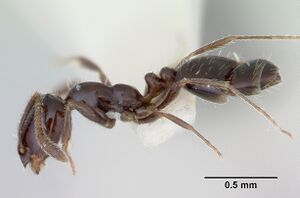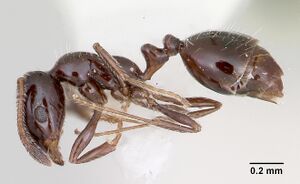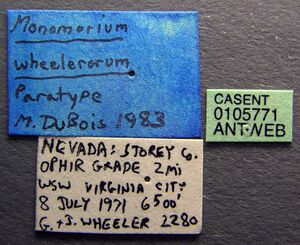Monomorium ergatogyna
| Monomorium ergatogyna | |
|---|---|

| |
| Scientific classification | |
| Kingdom: | Animalia |
| Phylum: | Arthropoda |
| Class: | Insecta |
| Order: | Hymenoptera |
| Family: | Formicidae |
| Subfamily: | Myrmicinae |
| Tribe: | Solenopsidini |
| Genus: | Monomorium |
| Species: | M. ergatogyna |
| Binomial name | |
| Monomorium ergatogyna Wheeler, W.M., 1904 | |
| Synonyms | |
| |
A southwestern U.S. species with unusually long-lived Monomorium queens.
| At a Glance | • Polygynous |
Identification
DuBois (1986) - A member of the Monomorium minimum species group. Queen: Wingless; head (excluding lateral margin of clypeus) lacking nonpiliferous punctures and rugae; alitrunk with more than 30 erect to suberect setae projecting above dorsal outline; mesopleuron punctate, PI 35-44 (38).
It is possible that queens of this species might be confused with queens of Monomorium cyaneum or Monomorium wheelerorum. Monomorium ergatogyna queens can be separated from those of M. cyaneum by the fringe of setae on the antennal scape and the reduced head sculpturing in M. ergatogyna.
Keys including this Species
- Key to Monomorium workers of the New World
- Key to Monomorium males of the New World
- Key to Monomorium queens of the New World
- Key to US Monomorium species
Distribution
Known from locally abundant populations occurring along Pacific coastal California, inland California sites in southern California, Nevada and Utah.
Latitudinal Distribution Pattern
Latitudinal Range: 41.69° to 22.95°.
| North Temperate |
North Subtropical |
Tropical | South Subtropical |
South Temperate |
- Source: AntMaps
Distribution based on Regional Taxon Lists
Nearctic Region: United States (type locality).
Neotropical Region: Mexico.
Distribution based on AntMaps
Distribution based on AntWeb specimens
Check data from AntWeb
Countries Occupied
| Number of countries occupied by this species based on AntWiki Regional Taxon Lists. In general, fewer countries occupied indicates a narrower range, while more countries indicates a more widespread species. |

|
Estimated Abundance
| Relative abundance based on number of AntMaps records per species (this species within the purple bar). Fewer records (to the left) indicates a less abundant/encountered species while more records (to the right) indicates more abundant/encountered species. |

|
Biology
DuBois (1986) - Recorded as nesting under stones (Brues, 1903), in soil or in rotten wood (Essig, 1926). Mallis (1941) records this species (misidentified as Monomorium minimum) nesting in a dry, unshaded area (in the Berkeley Hills) with tumuli forming tiny craters (2-4 cm in diameter). Further details of nest architecture are unknown. In addition to the variety of nesting sites occupied by M. ergatogyna, it has a wide altitudinal tolerance, from 9 m (Long Beach) through 1500 m (H James Reserve).
Monomorium ergatogyna queens have the longest recorded life span in this genus. Colonies (collected in the field) have been maintained in the laboratory for over two years with the original queens (pers. observ.). This compares with an average queen longevity of 39 weeks for Monomorium pharaonis (Peacock and Baxter, 1950) and 8 months to 1 year for M. minimum (pers. observ.). Monomorium ergatogyna worker longevity varies from 4-8 months (4 months appears to be the usual life span for workers of this genus). There appear to be three larval instars. Colonies of M. ergatogyna have multiple, functioning queens (2-6) (pers. observ.).
Sexual forms emerge during July and August {collections of reproductives: Santa Barbara Island, 12 June 1978 (gyne larvae); Santa Cruz Island, 23 July 1963 (1 male); East Anacapa Island, 23 August 1978 (10 males and 20 unmated queens)}. Only 2 males have been collected from the mainland {Pasadena, 17 April 1929}. If this date is correct, M. ergatogyna may produce sexuals twice a year. Another possibility is that an undescribed species occurs sympatrically with M. ergatogyna; no morphological differences have been found to support this theory.
Brues (1903) reported a species of Microdon (Diptera: Syrphidae) from a nest at Pacific Grove. No other symbionts have been reported.
It appears that the Argentine Ant, Linepithema humile (Mayr), occupies much of the habitat once utilized by M. ergatogyna (pers. observ.).
Flight Period
| X | |||||||||||
| Jan | Feb | Mar | Apr | May | Jun | Jul | Aug | Sep | Oct | Nov | Dec |
Source: antkeeping.info.
- Check details at Worldwide Ant Nuptial Flights Data, AntNupTracker and AntKeeping.
 Explore: Show all Flight Month data or Search these data. See also a list of all data tables or learn how data is managed.
Explore: Show all Flight Month data or Search these data. See also a list of all data tables or learn how data is managed.
Determination Clarifications
DuBois (1986) - A great deal of confusion in previous literature has resulted from the erroneous assumption that M. minimum and Monomorium viridum peninsulatum occurred in California. Furthermore, M. ergatogyna was thought to inhabit only the coastal islands (Essig, 1926; Mallis, 1941; Cook, 1953). Although the San Francisco and Los Angeles populations of this species currently appear allopatric, much more collecting must be done before this point can be decided. Additionally, there appear to be some minor size differences between queens from island localities versus those from the mainland. It seems best to regard all this material as M. ergatogyna.
Castes
Worker
Images from AntWeb
   
| |
| Worker. Specimen code casent0103532. Photographer April Nobile, uploaded by California Academy of Sciences. | Owned by USNM, Washington, DC, USA. |
   
| |
| Paratype of Monomorium ergatogyna. Worker. Specimen code casent0105771. Photographer April Nobile, uploaded by California Academy of Sciences. | Owned by USNM, Washington, DC, USA. |
Queen
Images from AntWeb
   
| |
| Paratype of Monomorium ergatogyna. Queen (alate/dealate). Specimen code casent0103533. Photographer April Nobile, uploaded by California Academy of Sciences. | Owned by USNM, Washington, DC, USA. |
Nomenclature
The following information is derived from Barry Bolton's Online Catalogue of the Ants of the World.
- ergatogyna. Monomorium minutum subsp. ergatogyna Wheeler, W.M. 1904d: 269 (w.q.) U.S.A. (California: Catalina I.).
- Type-material: lectotype ergatoid queen (by designation of DuBois, 1986: 88).
- [Note: DuBois, 1986: 88 , counts 21 workers, 16 queens in AMNH, and 12 workers, 17 queens in MCZC, all apparently from the type-locality. This does not tally with Wheeler’s original comment that the syntypes were “numerous workers and eight females taken from three different nests”.]
- Type-locality: U.S.A.: California, Catalina I., 1904 (C.F. Baker).
- Type-depositories: AMNH, MCZC.
- DuBois, 1986: 88 (m.).
- As unavailable (infrasubspecific) name: Emery, 1922e: 173.
- Junior synonym of minimum: Creighton, 1950a: 219; Smith, M.R. 1958c: 128; Smith, D.R. 1979: 1382; Snelling, R.R. & George, 1979:128.
- Subspecies of minimum: Wheeler, W.M. 1914b: 42 (in text); Wheeler, W.M. 1917a: 501; Wheeler, W.M. 1935g: 23; Smith, M.R. 1951a: 810.
- Status as species: Wheeler, W.M. 1910g: 562; Essig, 1926: 857; DuBois, 1986: 86 (redescription); Bolton, 1995b: 261; Ward, 2005: 14 (in text).
- Senior synonym of wheelerorum: Ward, 2005: 14.
- Distribution: U.S.A.
- wheelerorum. Monomorium wheelerorum DuBois, 1986: 91, figs. 11, 17, 80, 81-86 (w.q.) U.S.A. (Nevada, California, Utah).
- Type-material: holotype queen, 10 paratype workers, 4 paratype queens.
- Type-locality: holotype U.S.A.: Nevada, Clark County, Wheeler Spring, Spring Mts, 2012 m., no 1561 (G.C. & J. Wheeler); paratypes: 2 workers with same data, 2 workers, 1 queen Nevada, Washoe County, Davis Creek Park, 1554 m., no. 2366 (G.C. & J. Wheeler), 2 workers, 1 queen Nevada, Mullen Gap, W of S end Pyramid Lake, no. 1484 (I. LaRivers), 2 workers, 1 queen Nevada, Lyon County, Sand Canyon, 1981 m. (R. Betchel), 2 workers, 1 queen Nevada, Storey County, Ophir Grade, 3.2 km. WSW Virginia City, 1981 m., no. 2280 (G.C. & J. Wheeler).
- Type-depositories: LACM (holotype); LACM, MCZC, MBDC, UKLK, USNM (paratypes).
- Status as species: Bolton, 1995b: 268.
- Junior synonym of ergatogyna: Ward, 2005: 14.
Unless otherwise noted the text for the remainder of this section is reported from the publication that includes the original description.
Description


Worker
Head: (representing separate localities; N= 10) HL 0.40-0.60 (0.49), HW 0.33-0.42 (0.39), SL 0.31-0.40 (0.35), EL 0.06-0.10 (0.07), MOD 0.04-0.06 (0.05). Structure—CI 70-91 (79), SIL 62-85 (71), SIW 79-98 (89). In full frontal view, side straight. Scape reaching or surpassing occiput by less than length of pedicel. Alitrunk. PW 0.20-0.28 (0.25), PL 0.18-0.24 (0.20), WL 0.48-0.59 (0.52). Structure—Propodeum rounded; declivitous face half length of basal face. PI 35-44 (38). Pilosity—Dorsal surface of alitrunk with 18-25 erect to suberect setae. Sculpture—Anterior propodeal suture with moderate, longitudinal rugae. Petiole. Dorsum of node convex. Postpetiole. Anterior subpostpetiolar process of moderate size, located medially on venter. Setae erect on dorsum of node and on venter (beneath node), erect to suberect on sides, remainder bare. Posterior edge of postpetiole with dense, non-piliferous punctures. Color: Base of mandible, lateral margin of clypeus, and antenna yellow brown.
Queen
As described for Monomorium cyaneum except as indicated. Head. (representing different localities; N= 10). HL 0.59-0.71 (0.67), HW 0.55-0.65 (0.61), SL 0.41-0.52 (0.47), IOD 0.12-0.18 (0.17), OD 0.04-0.05 (0.05), EL 0.12-0.15 (0.14), MOD 0.09-0.11 (0.10). Structure—CI 79—95 (90), SIL 58-77 (70), SIW 63-91 (77). Side straight to slightly convex. Frontal carinae diverging strongly posteriorly. Pilosity—Setae erect near clypeus, frons, gula, occiput, and ocelli, suberect to decumbent on malar area, appressed on remainder. Setae of scape erect on anterior edge (forming a fringe of setae), decumbent to appressed on remainder, of pedicel and flagellum (except club) suberect to decumbent, of antennal club appressed. Sculpture—Smooth and shining except as follows: moderate, parallel, longitudinal rugae beginning all along lateral margin of clypeus and extending to level of antennal insertion. Small piliferous punctures evenly distributed on head. Alitrunk. PW 0.40-0.48 (0.43), PL 0.21-0.31 (0.28), WL 1.00-1.15 (1.06). Structure—Propodeum evenly rounded (basal and declivitous faces do not meet at an angle). PI 19-28 (26). Pilosity—As in Monomorium minimum. Sculpture—Large piliferous punctures on dorsum of scutum, smaller piliferous punctures on dorsum of scutellum, propodeum and side of alitrunk. Several moderate to large semicircular rugae anterior to propodeal spiracle. Petiole: Dorsum of node convex. Setae decumbent to appressed on anterior surface of node, erect on dorsum and side of node, and absent from posterior surface of node. Posterior surface of node with large, transverse, concentric, semicircular rugae which extend over half of side of node. Postpetiole. Dorsum of node convex. Dorsum and sides of node smooth with piliferous punctures. Posterior 1/5 of node with some non-piliferous punctures. Sometimes, lower 2/3 of side of node covered with dense, non-piliferous punctures. Color. Head brown except as follows: antenna, mandible, and lateral margin of clypeus yellow to yellow brown.
Male
Head. Measurements (representing 1 nest; N= 5) HL 0.55-0.58 (0.56), HW 0.66-0.71 (0.69), SL 0.29-0.35 (0.31), IOD 0.18—0.20 (0.19), OD 0.06 (0.06), EL 0.24-0.26 (0.25), MOD 0.12-0.16 (0.15). Structure—CI 114-127 (123), SIL 53-60 (55), SIW 41-53 (45). Sculpture—Large, concentric, transverse rugae occurring on posterior 1/3 of head. Large rugae beginning all along lateral margin of clypeus, continuing behind antennal insertion and converging with frontal carina. Occasionally, several moderate rugae may converge on anterior ocellus. Alitrunk: Measurements PW 0.49-0.56 (0.51), PL 0.38-0.42 (0.40), WL 1.28-1.29 (1.29). Structure—Pronotal-scutal suture located medially on alitrunk. Propodeum angular, basal and declivitous faces of approximately equal length. PI 29-33 (31). Wings present; 5-7 hamuli on hindwing. Pilosity—As in M. minimum. Sculpture—Anterior edge of mesopleuron, near procoxa, with series of small transverse rugae. Petiole. Dorsum of node convex. Setae subdecumbent to appressed on anterior surface of node, suberect to erect on dorsum, absent from posterior surface of node. Side of petiole with small non-piliferous punctures; dorsum smooth and shining with a few piliferous punctures. Postpetiole: Dorsum of node convex. Anterior subpostpetiolar process of moderate size, located medially on venter. Setae erect to suberect on dorsum and/or posterior surface of node; absent elsewhere. Dorsum of node smooth, remaining surfaces with dense non-piliferous punctures. Genitalia. Ninth sternite with 7-10 erect setae. Aedeagus with 13 teeth. Cuspis of volsella with 3 setae.
Type Material
DuBois (1986) - Syntypic series consists of “numerous workers and eight females taken from three different nests” (Wheeler, 1904). California: Los Angeles Ca, Catalina Island, Baker; (16 queens, 21 workers; American Museum of Natural History), (17 queens, 12 workers; Museum of Comparative Zoology). Lectotype queen selected from AMNH series bears red, handwritten label: Monomorium ergatogyna Wheeler Lectotype M. DuBois 1980.
References
- Chung, F.-Y., Hsu, P.-W., Hsu, F.-C., Lin, C.-C. 2025. A new genus in a hyperdiverse ant lineage (Hymenoptera: Formicidae: Myrmicinae) revealed by integration of morphological and molecular evidence. Myrmecological News 35: 29-60 (doi:10.25849/MYRMECOL.NEWS_035:029).
- Creighton, W. S. 1950a. The ants of North America. Bulletin of the Museum of Comparative Zoology 104: 1-585 (page 219, Junior synonym of minimum)
- DuBois, M. B. 1986. A revision of the native New World species of the ant genus Monomorium (minimum group) (Hymenoptera: Formicidae). University of Kansas Science Bulletin. 53(2):65-119.
- Essig, E. O. 1926. Insects of western North America. New York: Macmillan, xi + 1035 pp. (page 857, Raised to species)
- Jansen, G., Savolainen, R. 2010. Molecular phylogeny of the ant tribe Myrmicini (Hymenoptera: Formicidae). Zoological Journal of the Linnean Society 160(3), 482–495 (doi:10.1111/j.1096-3642.2009.00604.x).
- Ward, P.S. 2005. A synoptic review of the ants of California (Hymenoptera: Formicidae). Zootaxa 936: 1-68 (page 14, Senior synonym of wheelerorum)
- Wheeler, W. M. 1904e. Ants from Catalina Island, California. Bull. Am. Mus. Nat. Hist. 20: 269-271 (page 269, worker, queen described)
- Wheeler, W. M. 1914c. Ants collected by W. M. Mann in the state of Hidalgo, Mexico. J. N. Y. Entomol. Soc. 22: 37-61 (page 42, Subspecies of minimum)
References based on Global Ant Biodiversity Informatics
- Backlin, Adam R., Sara L. Compton, Zsolt B. Kahancza and Robert N. Fisher. 2005. Baseline Biodiversity Survey for Santa Catalina Island. Catalina Island Conservancy. 1-45.
- Boulton A.M. and P.S. Ward. 2002. Ants. Chapter 5 in A New island Biogeography of the Sea of Cortes. T.J. Case, M.L. Cody and E. Ezcurra. Oxford university Press.
- Clarke K.M., Fisher B.L. and LeBuhn G. 2008. The influece of urban park characteristics on ant (Hymenoptera, Formicidae) communities. Urban Ecosyst 11: 317-334
- Dattilo W. et al. 2019. MEXICO ANTS: incidence and abundance along the Nearctic-Neotropical interface. Ecology https://doi.org/10.1002/ecy.2944
- Des Lauriers J., and D. Ikeda. 2017. The ants (Hymenoptera: Formicidae) of the San Gabriel Mountains of Southern California, USA with an annotated list. In: Reynolds R. E. (Ed.) Desert Studies Symposium. California State University Desert Studies Consortium, 342 pp. Pages 264-277.
- DuBois M. B. 1986. A revision of the native New World species of the ant genus Monomorium (minimum group) (Hymenoptera: Formicidae). Univ. Kans. Sci. Bull. 53: 65-119
- DuBois, M.B. 1986, A revision of the native New World species of the ant genus Monomorium (minimum group) (Hymenoptera: Formicidae). The University of Kansas Science Bulletin 53(2):65-119
- Fisher B. L. 1997. A comparison of ant assemblages (Hymenoptera, Formicidae) on serpentine and non-serpentine soils in northern California. Insectes Sociaux 44: 23-33
- Fisher, B.L. 1997. A comparison of ant assemblages (Hymenoptera, Formicidae) on serpentine and non-serpentine soils in northern California. Insectes Sociaux 44:23-33.
- Greenberg L., M. Martinez, A. Tilzer, K. Nelson, S. Koening, and R. Cummings. 2015. Comparison of different protocols for control of the Red Imported Fire Ant, Solenopsis invicta Buren (Hymenoptera: Formicidae), in Orange County, California, including a list of co-occurring ants. Southwestern Entomologist 40(2): 297-305.
- Holway D.A. 1998. Effect of Argentine ant invasions on ground-dwelling arthropods in northern California riparian woodlands. Oecologia. 116: 252-258
- Johnson, R.A. and P.S. Ward. 2002. Biogeography and endemism of ants (Hymenoptera: Formicidae) in Baja California, Mexico: a first overview. Journal of Biogeography 29:10091026/
- Mallis A. 1941. A list of the ants of California with notes on their habits and distribution. Bulletin of the Southern California Academy of Sciences 40: 61-100.
- Matsuda T., G. Turschak, C. Brehme, C. Rochester, M. Mitrovich, and R. Fisher. 2011. Effects of Large-Scale Wildfires on Ground Foraging Ants (Hymenoptera: Formicidae) in Southern California. Environmental Entomology 40(2): 204-216.
- MontBlanc E. M., J. C. Chambers, and P. F. Brussard. 2007. Variation in ant populations with elevation, tree cover, and fire in a Pinyon-Juniper-dominated watershed. Western North American Naturalist 67(4): 469491.
- Ostoja S. M., E. W. Schupp, and K. Sivy. 2009. Ant assemblages in intact big sagebrush and converted cheatgrass-dominates habitats in Tooele County, Utah. Western North American Naturalist 69(2): 223234.
- Stahlschmidt Z. R., and D. Johnson. 2018. Moving targets: determinants of nutritional preferences and habitat use in an urban ant community. Urban Ecosystems 21: 1151–1158.
- Staubus W. J., E. S. Boyd, T. A. Adams, D. M. Spear, M. M. Dipman, W. M. Meyer III. 2015. Ant communities in native sage scrub, non-native grassland, and suburban habitats in Los Angeles County, USA: conservation implications. Journal of Insect Conservervation 19:669–680
- Vasquez-Bolanos M. 2011. Checklist of the ants (Hymenoptera: Formicidae) from Mexico. Dugesiana 18(1): 95-133.
- Vásquez-Bolaños M. 2011. Lista de especies de hormigas (Hymenoptera: Formicidae) para México. Dugesiana 18: 95-133
- Wetterer, J. K.; Ward, P. S.; Wetterer, A. L.; Longino, J. T.; Trager, J. C.; Miller, S. E. 2000. Ants (Hymenoptera: Formicidae) of Santa Cruz Island, California. Bulletin of the Southern California Academy of Sciences 99:25-31.
- Wetterer, J.K., P.S. Ward, A.L. Wetterer, J.T. Longino, J.C. Trager and S.E. Miller. 2000. Ants (Hymenoptera:Formicidae) of Santa Cruz Island, California. Bulletin of the Southern California Academy of Science 99(1):25-31.
- Wheeler W. M. 1917. The mountain ants of western North America. Proceedings of the American Academy of Arts and Sciences 52: 457-569.
- Wheeler, William Morton. 1904. Ants From Catalina Island, California. Bulletin of the American Museum of Natural History. XX. 269-271.
- Wheeler, William Morton. 1904. Ants from Catalina Island, California in Bulletin of the American Museum of Natural History. 20:269-271.

